In 2016, I reviewed the first Mysterious Benedict Society book by Trenton Lee Stewart. In 2021, DisneyPlus released the “Mysterious Benedict” t.v. series, which led to a renewal of interest in the entire Mysterious Benedict Society series. As I have now read all of the series and am working my way through the prequel and puzzle book, I am converting that review into a series review here. If you would like to know about the series generally or any of the books in particular, read on.
From the original 2016 review:
In the last year, I have felt strongly that God is raising up a generation of storytellers whose writing will inspire, nurture, and challenge this new generation of readers (and their parents) to confront the worldly darkness that seeks to extinguish our God-given light. I have been deeply grateful for these storytellers and their families who support them in their craft. They are writing stories that speak to the challenges we have, and they are subtly, or not so subtly, pointing us to the Maker who is the Prime Author. I am deeply grateful for living authors like S. D. Smith, N. D. Wilson, Jonathan Rogers, Andrew Peterson, and Phil & Erin Ulrich. Sam Smith has a wonderful video essay on this very topic that is well worth the watch.
The Mysterious Benedict Society is more secular than the Christian authors I listed above, but also timely and good. I know practically nothing about the author, and I don’t mean to presume any worldview or intention in his writing. According to an interview with NPR, Stewart claims The Hobbit and The Lion, The Witch, and the Wardrobe as his two favorite books from childhood. He seems to have excellent taste in children’s literature, and that makes me inclined to trust him a bit just for that.
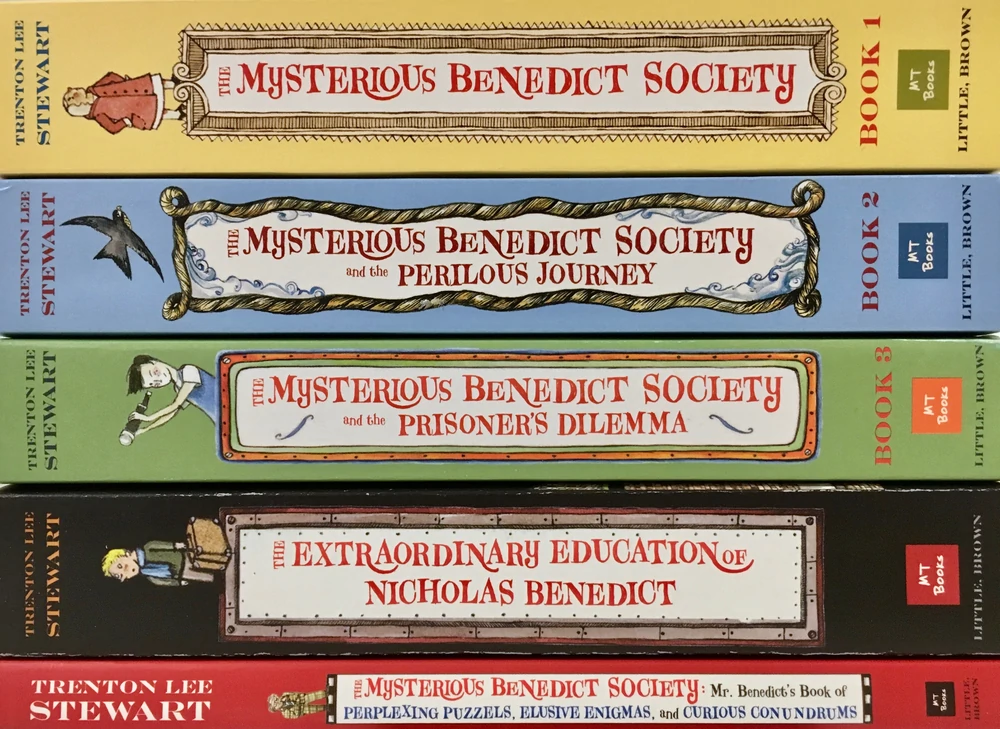
The Mysterious Benedict Society series of books chronicles the friendship of four unique children (three of whom are presumed to be orphans, and the other is a runaway) as they are recruited by Nicholas Benedict to do a job that only uniquely gifted and special kids can do. This exciting and intelligent book series celebrates the good that happens when people of differing gifts work together for a common good. And, because much of the story centers on riddles and puzzles, the reader is challenged to solve the riddles for himself as he reads.
Because several of the children are orphans, there is a beautiful adoption theme that runs throughout the books. Mr. Benedict and his assistants, Number Two, Rhonda, and Milligan, are worthy adults and interesting characters. The same can be said of the other members of the “family” that we get to know as the story evolves.
The series is fun to read because it is so creative and the characters are so well-drawn. The combination of plot twists, puzzles, riddles, and teamwork makes for good storytelling, and the reader wants to keep reading to see how it all comes together.
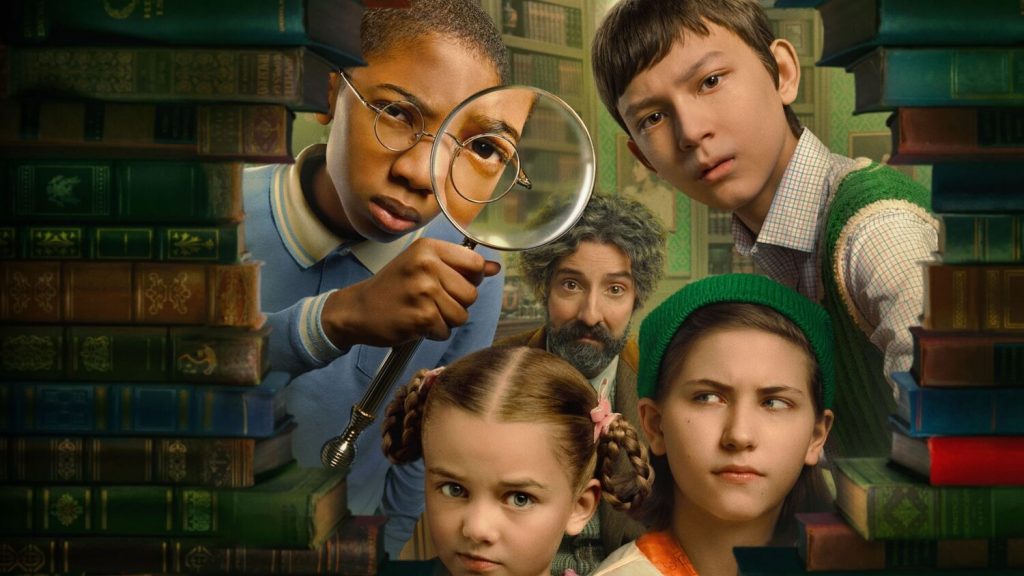
This series of books is enjoying renewed interest due to the popular “Mysterious Benedict Society” adaptation for DisneyPlus. The first season more or less covers the first book. I am a purist. I like my movies (or t.v. adaptations) to accurately reflect the book. This one is different from the book, including not having Mr. Curtain in a wheelchair. This, and some other strange reinterpretations, felt unnecessary to me, and disappointing. Although, some of the choices I understood a little bit better as I finished the books. I think Disney decided to draw on the whole series when writing the script for the first season. That said, the casting is brilliant, the visuals are compelling, and the story plays out well over eight episodes. Despite my disappointment in what seems to me to be unnecessary changes, I enjoyed the series enough to watch it twice with my children and to hope they make each book into additional seasons.
In each of the sections below, I will work to avoid spoilers for the book being discussed. However, in the subsequent books, I will assume that you have either read the previous books or that you do not mind some small spoilers. Therefore, please read on with caution.
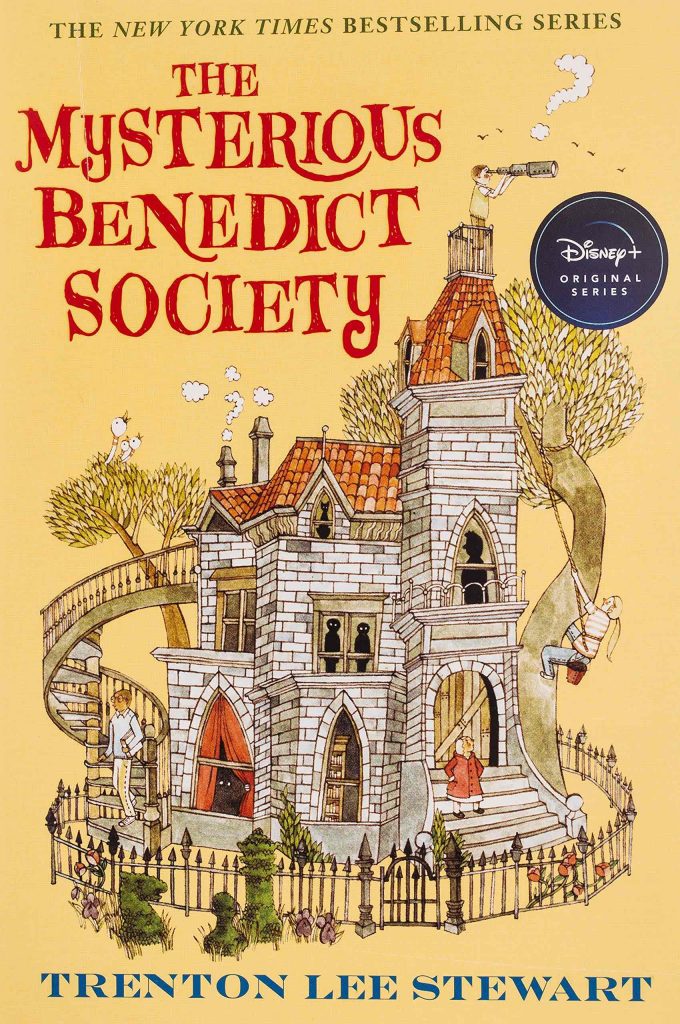
1: The Mysterious Benedict Society
When The Mysterious Benedict Society book opens, we meet Reynie Muldoon. Reynie is an orphan, and is intellectually gifted. His tutor, Miss Perumal, suggests that he should respond to a newspaper ad that is looking for gifted children who would like to pursue special opportunities. When he arrives at the testing site, things become very puzzling. Reynie completes the test and learns that it is only the first of several tests. And, that in his group, he is the only one who passed.
At the next test, Reynie meets other children who were the only ones to pass the test in their respective groups. And again, the test is very strange and has a twist.
In the chapter “Squares and Arrows,” each of the children is tested in a room that has a floor that is painted with a blue, black, and yellow checkerboard pattern. On the facing wall, there is a sign that reads: “CROSS THE ROOM WITHOUT SETTING FOOT ON A BLUE OR BLACK SQUARE.” Each child handles the challenge differently. Kate solves it with incredible physical ingenuity and some acrobatics. Sticky solves it almost mathematically. Reynie solves it by noticing that the rectangles are not squares and therefore this is a trick. Each child passes the test because each solves it despite solving it differently than their peers.
Several times throughout the testing, there are hidden character tests. Like when each is offered the opportunity to cheat, or when they risk not finishing the test at all because they decide to work as a team and leave no one behind. As Mr. Benedict explains, there are tests and then there are tests. It is clear that what Mr. Benedict is looking for is a group of children who have unconventional but essential intellectual and physical gifts, a deft ability to problem-solve, and the right kind of moral fitness.
There is much to appreciate in this almost 500-page adventure novel and series starter. It is incredibly clever, the characters are so well-drawn that they almost instantly feel familiar, the story has strong pro-life and adoption themes, and the characters are doing noble work.
There are moral cheats or blind spots, however. In one case, the team is forced to cheat on a test in order to maintain their cover. The characters are anguished about it, but ultimately let the circumstance dictate their moral code. It is additionally frustrating that it is the adult mentors who suggest cheating.
In another situation, the kids need their peers to get sick so they can maintain their cover, and so their numbers can come up more quickly in a rotation. Our heroes instigate widespread food poisoning and, sadly, relish the pain it causes to their enemies.
You can learn more about this book at Biblioguides here. You can purchase this book here.
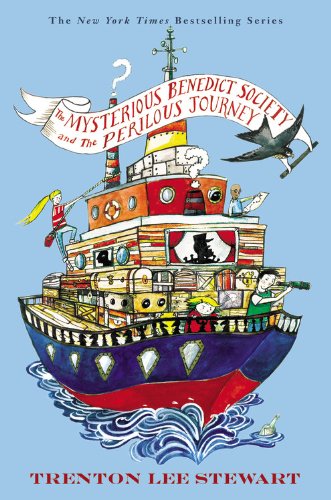
2: The Mysterious Benedict Society and the Perilous Journey
The Mysterious Benedict Society and the Perilous Journey opens with Kate Wetherall living on a farm with her dad, Milligan, and waiting for the arrival of Reynie and Sticky. Kate is clearly happy, healthy, and growing in confidence from the restoration of her family. Because Milligan’s memory has been restored, he has a better understanding of his talents and skills. Mr. Benedict continues to rely on Milligan’s gifts as they work together to use The Whisperer to heal the minds of as many of Mr. Curtain’s victims as they can find.
At the end of the first book, Reynie Muldoon is adopted by Miss Perumal. We learn in this book that Reynie has gained not only an “Amma” (the Tamil word for “mom”) but also a “Pati” (grandmother) in Miss Perumal’s mother. The trio live happily together, and are driving to Kate’s farm to rendezvous with the Wetheralls and Washingtons before all of them head to Mr. Benedict’s mansion to see the other friends there.
When Sticky Washington returns from their adventures at the end of the first book, he is reunited with his parents. In the year since that reunion, the family has improved tremendously. Sticky has learned to trust his parents, and they have become worthy of that trust.
The children are heading to Mr. Benedict’s home because Mr. Benedict and the adults have been planning a surprise for all of the children in honor of the one-year anniversary of their success at Mr. Curtain’s school. When they get to the mansion, however, they discover that Mr. Benedict and Number Two have been kidnapped. It would seem that the plans Mr. Benedict had for their surprise will have to wait. But, of course, that would not make a very interesting story.
When the children are reunited with Rhonda and Constance, Rhonda gives Constance an “early birthday present” from Mr. Benedict. The children also find a travel journal from Mr. Benedict which gives the children clues about where they may be able to find Mr. Benedict. Deciding to follow the puzzles or clues in the journal, the children break away from their families and head out on a dangerous but exciting adventure.
In order to begin this journey, the children sneak away from their parents; parents who have proven themselves worthy of trust. It becomes obvious to the children that this was a mistake. When they are saved by Milligan at one point, he gives them a stern lecture admonishing them that, despite having excellent motives, they made the wrong choice, and it could have been a deadly one. As a parent, I enjoyed this scene, because I loved seeing Milligan being both a hero and a father. It is clear that with his memory intact, he is a force to be reckoned with, and a father worth loving and obeying. The children do disobey him soon after, but that isn’t too surprising.
The love the adults have for the children is obvious and beautiful. When, in the first book, Milligan honestly says that he would give his life for the children, it becomes more poignant in this book. In this book, he is more than just a hero, he is a father who knows what it is to have lost Kate once. In one scene we see him trade his life for hers, and are left to wonder if that is the end of him.* While Milligan has a larger role than the other adults, it is clear that all of them deeply love the children, and are capable of sacrifice.
The story travels through several countries and across varied landscapes while delighting the imagination. The puzzles are more subtle than those in the first book, but still provide intellectual satisfaction to the reader. The children do well enough on their own, but they do their best work when they collaborate with worthy adults. Most importantly, each of the children has matured and is becoming a more complex character who better understands his or her power when they work together and trust each other.
One word of caution: when the story opens, Kate is practicing the art of swallowing a key so she can regurgitate it for later use. Presumably like most readers, Reynie is grossed out by this. This “trick” does prove useful later on. Parents may wish to know this so as to dissuade their children from attempting to imitate Kate.
If you liked the first offering of The Mysterious Benedict Society, you will likely enjoy this one. This one is also available in audio with the same great narrator.
You can learn more about this book at Biblioguides here. You can purchase this book here.
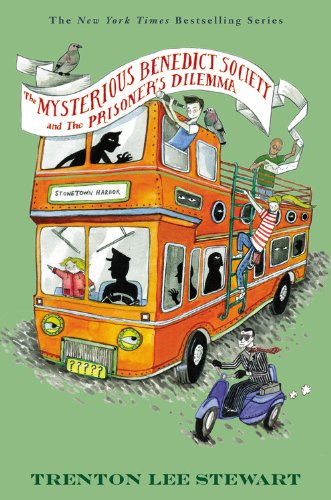
3: The Mysterious Benedict Society and the Prisoner’s Dilemma
The Mysterious Benedict Society and the Prisoner’s Dilemma is my favorite book of the series.
With Mr. Curtain escaping capture at the end of the second book, the children and their families have all moved in with Mr. Benedict as a safety precaution. In so doing, the friendship between the families blossoms into real love, and they realize that they have become one big extended family. This idea just furthers the beautiful themes of love, family, and life that these books celebrate.
I think the reason this book might be my favorite is because of two factors: the adults, and Mr. Benedict in particular, are much more present in the story, and because the relationships between the children have matured and developed into something more lovely. More so than in the previous books, the children are bonded, and they truly love each other. This is especially evident in the care they take to protect each other and the sacrifices they make for each other. In particular, I grew more and more impressed with the unspoken but palpable kinship that exists between Reynie and Constance, and the sweet ways in which Kate loves Constance and how Constance lets her. Truly, Constance Contraire is learning how not to be so contrary. Also, we get more of SQ in this story, and we better understand why he always seems so foggy-headed.
The first three books of the series were published one per year starting in 2007. When this book ended, it really felt to me like it was supposed to be the end of the series. It wraps up neatly, it ends happily, and our questions are answered.
You can learn more about this book at Biblioguides here. You can purchase this book here.
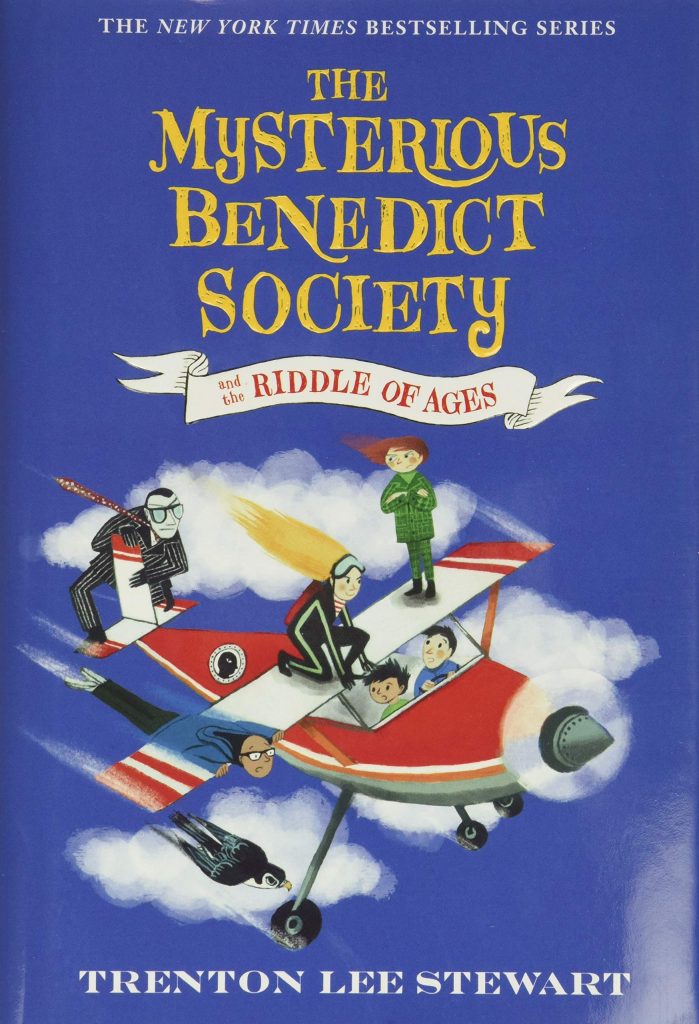
4: The Mysterious Benedict Society and the Riddle of Ages
When the fourth book, The Mysterious Benedict Society and the Riddle of Ages begins, it is much later. The setting of the book is approximately five to seven years later than the trilogy books. And the book itself was published ten years later (2019). As I said above, the third book felt like the ending of a trilogy. And this book feels like Stewart wrote a book that grew up with his original audience.
Riddle of Ages feels like something different from the other books. In this book, the children are all wrestling with being much changed from who they were during their early adventures and who they are becoming. Each of the three older children senses that they are at the end of something beautiful and the beginning of something new and unsettling. Each of them feels some resistance at having to stand so close to the precipice of a new life. And Constance, who is so much younger than the others, feels much worse than the others do as she feels left behind, lonely, and left out. Throughout this adventure, we witness the coming of age of the children, and get an unexpected but happy ending that leaves the reader with the assurance that our beloved characters will be more than okay, and that their lives will continue to be extraordinary, but that they will live them together. Stewart makes it clear that he is done telling this story, and that if we want more adventures for our characters, we will have to imagine them for ourselves.
I used the expression “coming of age.” In many modern books, that could imply some challenging themes. Stewart seems to respect his readers too much to mar his book with junk. We know, through Constance’s telepathic discoveries, that at one time or another, Kate had a crush on each of the boys, and each of the boys had a crush on her. But at no time was any of that said or explored. Constance assures us that each loved the team too much to risk it by mixing in romance. That said, I do think that Stewart gives us a few gentle and sweet hints about the future. My kids and I think someday, in the far future, Sticky and Kate do end up together. And, I have been convinced since the first book that when Constance grows up the special connection between her and Reynie will prove to be fertile ground for a meaningful relationship.
In the time that has passed between Prisoner’s Dilemma and Riddle of Ages, the community of children, their parents, and the other adults connected to them has become tight-knit. All are still living together except for Rhonda, who has gotten married and moved away. When the story opens, Reynie is working at his desk contemplating a problem that they are working on, Sticky is working in the lab on some chemical experiments, and Kate is away from home but radioing in. Constance is noticeably not mentioned for a while.
Each of the three older children has been reluctantly making plans to leave the nest and make their way in the world. Each has had very compelling offers and a lot of good options. But each is afraid of being the first to leave. And each, Sticky especially, is misunderstanding the others and feeling defensive and insecure. Because they love each other and are afraid of getting hurt, they are nursing their insecurities and withholding their hearts from each other. As the story gets started, a precocious and adorable five-year-old boy, Tai, walks into the mansion and up to Reynie’s study. We find out that he is a telepath being hunted by Mr. Curtain’s minions, and Constance has guided him to them for his safety. The presence of an impulsive, curious, and childish telepath in the mix ultimately breaks down barriers between the Mysterious Benedict Society members. Tai, without their permission, frequently blurts out the private thoughts of the membership at all of the most awkward moments, which ultimately promotes healing and honest communication between the members.
This book is just like the others in the aspect of puzzles, adventure, teamwork, and friendship. It is a fast-paced and exciting read with unexpected twists and moments of incredible tenderness.
“He took a few deep breaths, put on his goggles, and waited for the sign from Number Two. Before long she was holding up two fingers. Then one finger. Then she placed a hand over her heart and nodded at him. Reynie returned the gesture and went to the door.”
Page 253
In the last quarter of the book, the children are on a very dangerous and serious mission to rescue Mr. Benedict. When each of them takes their leave of other beloved characters (Rhonda, Number Two, etc.), the seriousness of the mission makes those farewells poignant. In each farewell, it is the last time those characters speak to us as readers. I felt like Stewart was letting them say goodbye to me as the reader. It was sweetly done and felt special.
I still love Prisoner’s Dilemma best, but this was a fantastic book. I have truly enjoyed this series, and think it ended just when and how it should. And I think Stewart wisely wrote full and beautiful stories, and stopped when they were told, instead of taking advantage of the reader’s money, and writing an endless series which diminishes as it goes on.
NOTE: If you are interested in the Audible version of the series, Riddle of Ages has a different narrator than all of the others (including the prequel, Extraordinary Education of Nicholas Benedict). At first, I was furious because I love Del Roy’s narration. But, since this was a coming-of-age story, I did end up loving the young voice of Eric Pollins as much as Del Roy.
Supplemental Books
There are two other Mysterious Benedict Society books, but they are not part of the series.
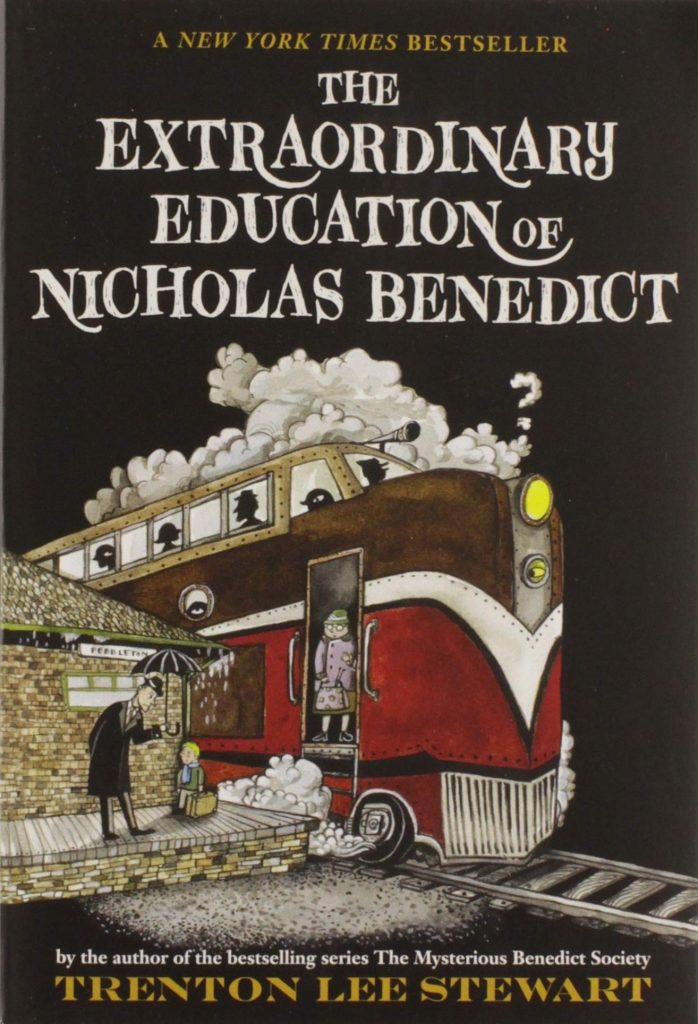
The Extraordinary Education of Nicholas Benedict is a story about Mr. Benedict’s childhood. I strongly advise reading this after the series. The Audible version of this book features Del Roy again.
When I began reading this book I was sad. I had just finished up with characters I loved, and I was being transported backward in time to a cold and frustrating orphanage setting. Nicholas wasn’t winning me over, and I was sincerely concerned that this story would be a dud. In fact, I was so concerned that I reached out to other readers in Tolle Lege to ask if they could encourage me before I resolved to put the book down. They did. And I am so glad they were there to push me to keep reading. One friend said: “It is important to know that Nicholas distrusted adults (with good reason) but that that would change and it would be essential to his character that it did.” That perspective shaped how I read this book and kept me going forward until I wanted to go forward on my own.
In this Mysterious Benedict Society prequel, we meet Nicholas Benedict as he is being transferred from one orphanage to another. His reception at Rothschild’s End is cold and unsettling with the exception of one glimmer of warmth: another orphan named John Cole. Readers of Riddle of Ages will recognize the name as Farmer John Cole who burns part of his crop fields to make a quick airfield for the Society. When we meet John Cole in Riddle, we are given just enough detail to get the sense that this is a character we will come to love as much as our Society members, but we are not given enough time to know him or even know his wife’s name. When we meet John at Rothschild’s End, we delight in the knowledge that we will get more of his story. The same can be said of Violet Hopefield. When we meet her in this book, we are reminded of the many paintings that hung in Mr. Benedict’s home in the other books that were painted by his childhood friend Violet. These two comforts help us to bear the sadness of the orphanage.
Nicholas has an impassioned distrust of adults. Throughout the story, he reflects on how he has never known one to advocate for a child other than their own children. Nicholas is convinced that as children grow up, they learn to be selfish as a way of being self-preserving and that it is best to master that skill now. Consequently, he is a loner who views everyone, with rare exceptions, as an enemy or competitor of some kind. John Cole is the first person who is able to penetrate Nicholas’s guarded nature. Through friendship with John and then Violet, Nicholas begins to care about something and someone other than himself.
Because of his distrust of adults, Nicholas does not respect the rules that adults set. Throughout the book, Nicholas uses his good manners to manipulate adults, he sneaks around outside of curfew, and he lies at will. While his intentions are good, and his objectives are healthy, the behavior is not a model we would want for our children. This is what bothered me so much in my early reading. It does change. And Nicholas does mostly repent of it.
When everything turns upside down, Nicholas runs away from the orphanage. In his flight, he is observed by a fellow traveler who ultimately earns Nicholas’s confidence. This traveler turns out to be a man of impeccable character and goodwill. And, his acts of kindness towards Nicholas change the entire trajectory of Nicholas’s life. With some surprising twists and turns, Nicholas returns to the orphanage with a new mission to become a man of virtue and charity. This decision ultimately impacts the lives of many and leads us to a very satisfying conclusion to a fascinating book.
It was very clear to me that this portrait of Nicholas is designed to contrast him with his twin brother Ledroptha Curtain. While we have no mention of the brother in this book, we see that the path that Nicholas was on would have made him into something just like Mr. Curtain, had not John, Violet, and his run-away experience changed everything. It is clear that nurture is just as important as nature in the shaping of a hero or villain.
While the story ends well, I have the impression that there are still many relevant stories to be told in this world. We know nothing of Violet’s future. We never got the story about why Farmer John Cole named his dog Nicholas, despite him telling the Society that it comes from a very funny memory shared between him and Nicholas in childhood. It would be delightful if Trenton Lee Stewart would give us another book or two – a little more about Nicholas, John, and Violet, and a book about how and why Nicholas and Ledroptha were separated.
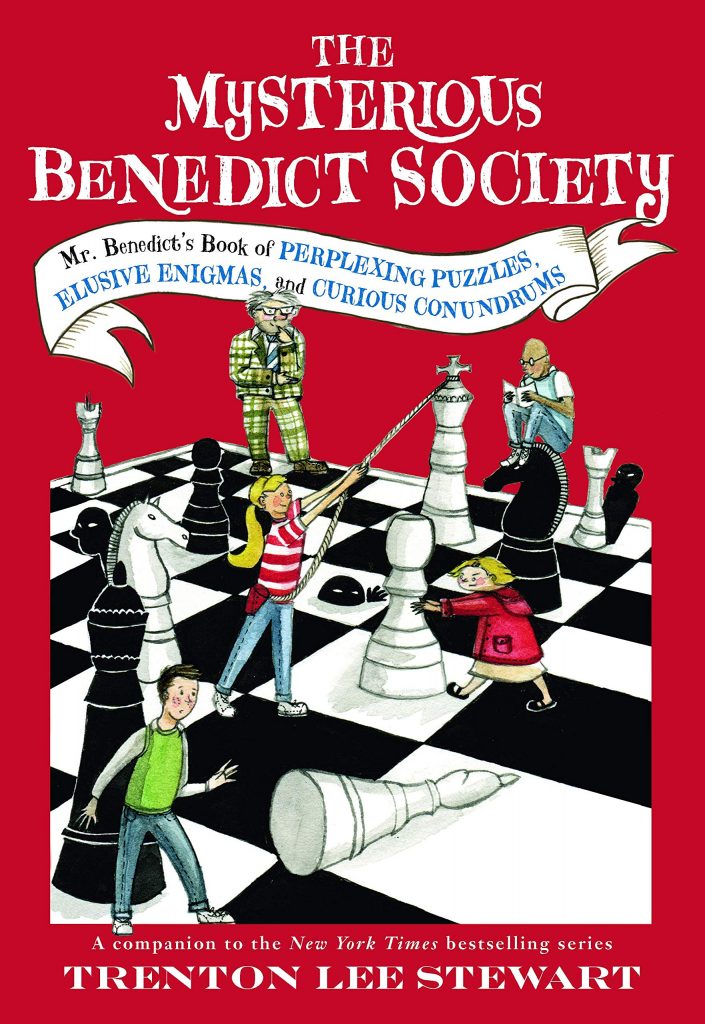
The Mysterious Benedict Society: Mr. Benedict’s Book of Perplexing Puzzles, Elusive Enigmas, and Curious Conundrums is a supplemental book that is not part of the stories, but is drawn out of them. Some of the puzzles from the stories are repeated or are similar, but the rest are fresh and new puzzles designed to bend our brains further. I strongly advise reading anytime after the first book. It contains spoilers for the first book, and some slight hints at the other books in the series.
Sara, I am so thrilled to have found you on Facebook and now to realize what a treasure your site is. I was considering adding this book to our collection, but I find it so hard to assess modern books by their small blurb on the back and so I often just avoid them. Your review is thoughtful and thorough and I thank you for it!
Hello Camille!! God be praised for social media. Seriously! It is such a blessing to be able to connect with other kindred spirits over important things like books, faith, and education. I am so glad that we are walking together on this journey!
I am so glad that this review is helpful. Like you, I listen to what people recommend, I read the blurbs, look at GoodReads reviews… and I still wonder. We decided that part of our mission here would be to give parents an ingredient list for each book we review. “Expect to find these things… we like these things… these things leave us troubled… you decide for your family.”
I am so glad that it is helpful. We love old books, but we know that many modern books rightfully are vying for our attention. It is important to know what is in them.